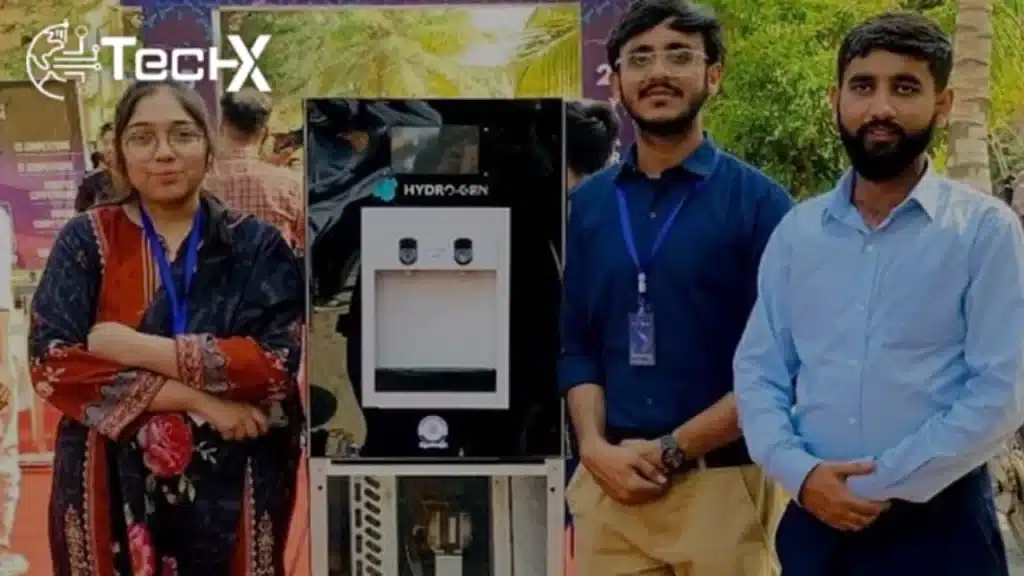A group of talented students from Bahria University has made a significant contribution to solving Pakistan’s water crisis by developing an innovative device called “Hydrogen.” This machine has the ability to extract water directly from the air’s humidity, offering a groundbreaking solution to the country’s ongoing water scarcity problems. With Pakistan facing severe water shortages, this invention could be a game-changer in providing access to clean water for communities in need.
Combating Water Scarcity in Pakistan
Pakistan has been grappling with water shortages for years, with many regions facing extreme scarcity due to a combination of climate change, over-extraction, and poor water management. This issue is particularly severe in rural areas, where access to clean drinking water is limited. The Hydrogen device developed by Bahria University students addresses this problem by providing a sustainable way to generate water directly from the atmosphere, ensuring a continuous supply of safe drinking water.
How the Hydrogen Device Works
The Hydrogen device operates by capturing moisture from the air and converting it into clean, drinkable water. It uses a highly efficient condensation process, which extracts up to 60% of the atmospheric moisture present in the air. This water is then filtered to ensure that it meets safety and health standards, making it suitable for consumption. The machine works effectively in both humid and semi-humid environments, making it adaptable to a variety of climate conditions across Pakistan.
Cost-Effective Water Solution
One of the most remarkable aspects of the Hydrogen device is its cost-effectiveness. According to the students behind the project, the water produced by the machine is 70% cheaper than bottled water available in the market. This makes it an affordable solution for people living in underserved areas who may not have the financial means to access bottled or purified water. Additionally, the low production costs make it viable for larger-scale implementation in both urban and rural settings.
Also Read: Karachi University introduces a new 4 year BS degree program
Powered by Solar Energy
The Hydrogen device becomes even more efficient and environmentally friendly when paired with solar energy. When powered by solar panels, the cost of producing one liter of water drops to an astonishingly low rate of Re0.50. This makes the device not only affordable but also sustainable, as it harnesses renewable energy sources to operate. By reducing the dependency on non-renewable energy, the machine aligns with global efforts to promote sustainability and reduce carbon footprints.
Addressing Environmental Challenges with Innovation
The students’ invention is a testament to how technology can be used to address pressing environmental challenges. Water scarcity is a major issue worldwide, and Pakistan is among the countries that are severely affected. By developing a machine that can produce water from air, these students have shown how innovative thinking and practical technology can offer real solutions. The Hydrogen device provides hope for regions struggling with water shortages, showing that sustainable solutions are possible.
Potential for Widespread Use
The potential applications for the Hydrogen device are vast. It could be deployed in areas suffering from severe droughts or where groundwater supplies are dwindling. Additionally, it has the potential to benefit disaster-stricken regions where access to clean water is cut off. The students’ invention could also be used in urban areas to supplement existing water supplies, reducing the strain on traditional water sources. Its versatility makes it a promising tool for addressing water scarcity on multiple fronts.
Benefits for Rural Communities
Rural communities in Pakistan often face the greatest challenges when it comes to accessing clean water. The Hydrogen device could make a significant difference in these areas, where infrastructure for water delivery is lacking, and residents are forced to rely on unsafe water sources. By providing a low-cost, sustainable option for water production, this machine could help improve public health and reduce waterborne diseases in these vulnerable communities.
A Step Forward in Sustainable Technology
This invention represents a major step forward in the field of sustainable technology. It showcases the potential for low-cost, high-impact solutions that not only address specific problems but also promote broader sustainability goals. The Hydrogen device, with its ability to harness natural resources like air and sunlight, serves as an example of how innovative technologies can be both environmentally friendly and economically feasible.
A Bright Future for Pakistani Innovation
The development of the Hydrogen device by Bahria University students is a proud moment for Pakistani innovation. It highlights the talent and creativity of the country’s youth and their ability to tackle complex environmental and social challenges. The success of this project reflects the importance of encouraging innovation in education and supporting young minds in their pursuit of creating solutions that have a lasting impact on society.
Conclusion
The Hydrogen device is more than just a technological achievement; it is a symbol of hope for addressing one of Pakistan’s most pressing issues—water scarcity. By extracting water from air humidity and offering a cost-effective, sustainable solution, the students of Bahria University have made a remarkable contribution to the fight against water shortages. Their innovation offers a glimpse into the future of water technology, where creative solutions can make clean water accessible to all.
